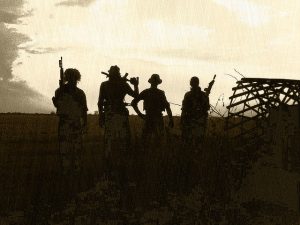Brain Damage in Veterans

Problems resulting from combat are not only psychological, real brain damage can occur from blasts. (Flickr / Creative Commons / Luca Melloni)
In a new study published in The Lancet Neurology, Dr. Daniel Perl found a brown dust pattern in brains of soldiers injured by blasts. These results show that PTSD is probably not just psychological. There are tangible results of brain damage that show up on the brain scan.
These results echo a blog that I wrote many years ago. “As long as soldiers have been getting hit in the head there have been veterans of those wars who have been disabled by brain injury,” the blog reads. Ironically, we looked at Lancet publications from 100 years ago when we did our extensive piece on the Nightmare of War Time Brain Injury. The articles we studied 100 years ago were articles Lancet had published on “shell shock.” We argued in 2009 that “shell shock” was brain damage, not evidence of a weak minded soldier.
The symptoms of the brain injured soldier in the study include memory loss, cognitive problems, inability to sleep, and profound, even suicidal, depression. After WWI, brain injury was classified as “shell shock.” Nowadays, it’s often attributed to PTSD. This theme was reflected in that same blog from many years ago.
“When organic brain damage gets minimized in combat, then all survivors of brain injury get labeled as having a psychiatric disease,” our blog reads.
In the current study, the people exposed to blasts were compared to control groups with and without brain damage. The five men in the experimental group all experienced symptoms of PTSD. The physical scarring suggests that the blast could have caused or worsened psychological troubles. Again, this is reflected in my blog from years before this study was published.
“Someone who is undergoing the stress event which can cause PTSD will have considerably more vulnerability to the organic injury of TBI,” we said last decade. “Likewise, someone who is undergoing the confusion, maladaptation of TBI, will be that much more prone to be negatively impacted by the stress that can cause PTSD.”
One of the most important implications of this study is that soldiers need to be protected from blast damage. This includes the helmet, being properly worn. The helmet was one of the earliest pieces of gear used for protection. It is vital that soldiers are properly protected from blasts to prevent severe brain damage. But helmets are there primarily to protect the skull. While they minimize brain damage when the head receives a direct blow or bullet, they are poorly suited to eliminate the wave forces which come with head injury.
Even though this study in ways is only discovering pathological evidence of things that the scientific community knew, or should have known for decades, we hope it will have a comparable impact to Omalu’s pathological study on former football players had in 2002. Many types of neurological damage can only be “seen” on autopsy. But that doesn’t mean that medical community can’t understand those injuries and treat those deficits in the living.








